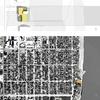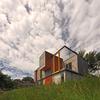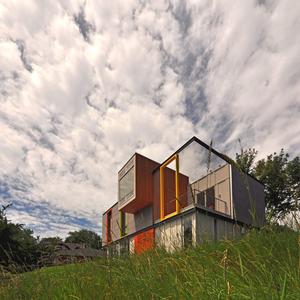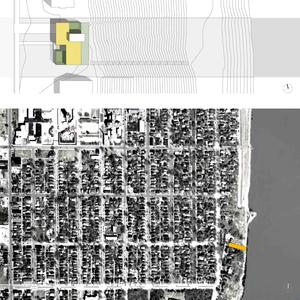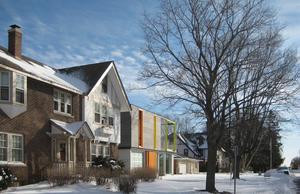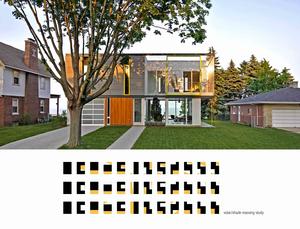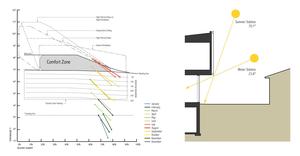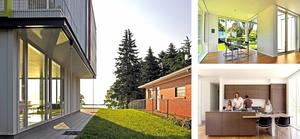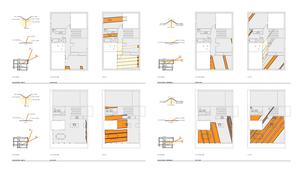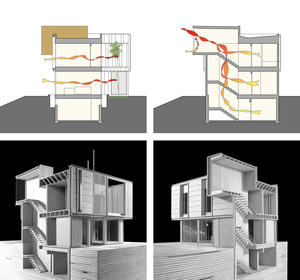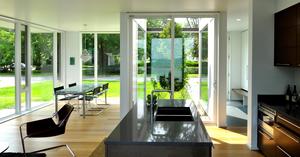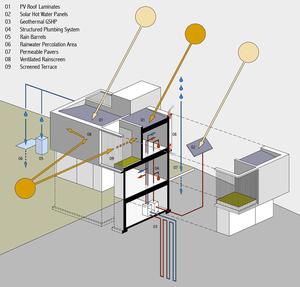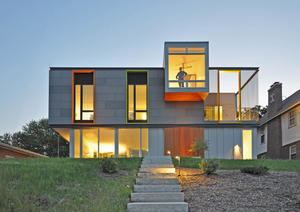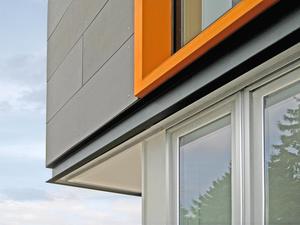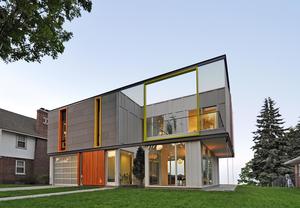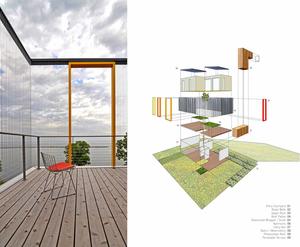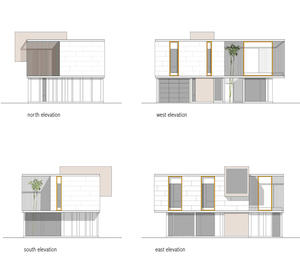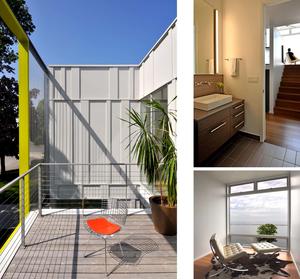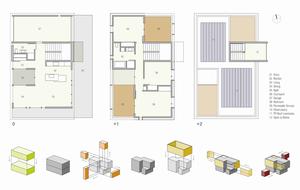OS House
Project Overview
Located in an old downtown neighborhood in Racine, Wisconsin, this house for a young family demonstrates how a small, sustainable residence built with a moderate budget can fit into a rustbelt city suffering from decades of economic decline. One of the first LEED Platinum homes in the Upper Midwest, the house occupies a narrow infill lot along the edge of Lake Michigan, completing a row of residences built over the last century. Based on massing studies testing the building's performance in relation to site constraints, solar exposure, and vegetation, the building is a simple rectangular volume with a series of outdoor rooms—an entry court, elevated patios, and a main-level terrace—all confined within the boundaries of the rectangular volume itself. The main level's transparency allows for a visual link between the street and the lake, while the upper rainscreen system creates a deep, ventilated envelope with superior performance. Along the edges of the outdoor rooms, the façade transforms into a delicate scrim of aluminum rods, defining spatial boundaries without obstructing views.
Design & Innovation
The majority of LEED-certified homes are built in suburbia and exurbia. While they may be "green" in terms of energy performance, they also perpetuate unsustainable settlement patterns. This project exemplifies an alternative model: a small, durable, high-performance residence embedded in an established neighborhood, taking advantage of an existing infrastructure and incorporating sustainable design principles and systems to minimize the building's ecological footprint and its dependence on the energy grid.
Smallness was key, for environmental and fiscal reasons. A rigorous reevaluation of the initial program allowed us to distill it to its bare essentials, eliminating space-consuming areas like walk-in closets, individual bathrooms, and oversized bedrooms. A one-car garage with bike storage was integrated into the simple volume of the house. Taking advantage of the lake breeze and the site's solar exposure, outdoor rooms were created to reduce the house's depth, allowing for maximum natural cross-ventilation and daylight. In order to maintain a visual link between the street and Lake Michigan, the neighborhood's greatest natural asset, a hybrid building envelope balances the desire for transparency with the need for superior thermal performance, combining the benefits of high-efficiency glazing with a super-insulated rainscreen system.
Regional/Community Design
The family’s decision to build a home within the city of Racine, a former manufacturing center maimed by decades of economic stagnation and urban disinvestment, was based on the conviction that the country’s economic and ecological future is directly tied to the well-being of its urban cores, and that life in a tightly knit, culturally diverse community is superior to that in bucolic isolation. Building in the city has a lasting impact on the local economy, strengthens the neighborhood’s social fabric, and is economically and environmentally prudent because it can tap into existing infrastructure networks and resources—a sustainable alternative to the resource-intensive greenfield developments that are still the norm in America’s continuous outward sprawl.
The project occupies a narrow urban infill lot, completing the missing link within the established architectural street façade and adding density to the immediate surroundings. The site provides its occupants easy access to the heart of the city. Restaurants, local shops, public parks, and the lake front are all within walking distance, and numerous other venues can be accessed by bus, with more than 80 bus stops within a half-mile radius of the project site.
Metrics
Land Use & Site Ecology
Situated on a formerly vacant urban parcel, the project repairs the street edge and adds immediate density to a well established neighborhood in this old Midwestern city, avoiding the environmental impact of developing suburban greenfields or productive farmlands.
The site, a steep bluff between the edge of the city and Lake Michigan and partially filled with old debris, required an extensive geotechnical analysis to understand drainage characteristics and ensure its long-term stability. The house was located on the upper plateau of the lot, well above the 100-year flood plane, where it minimizes its impact on the site’s topographic and ecological characteristics. Limiting construction to the plateau also simplified the construction process, providing construction equipment access to all sides of the house without altering the slope. The building is positioned next to a 100-year-old maple tree, its crown shading the west side of the house from the summer’s late-afternoon sun. Prairie grasses replaced existing invasive species to stabilize the slope, complemented by drought-resistant turf and native bushes around the house. All hard surfaces, including the driveway and the terrace, are permeable to allow stormwater to percolate into the ground.
Bioclimatic Design
The local climate, with its very cold winters and hot, humid summers, required a careful mix of active and passive design strategies to ensure proper interior conditioning. The structure is elongated along the north-south axis to take advantage of the cool eastern lake breezes during the summer, while high-performance, low-e, argon-filled operating windows in all rooms provide cross-ventilation throughout the house. A centrally located staircase functions as a thermal chimney, allowing warmer air on the main level to escape through operable windows in the upper observatory. The large southern overhang minimizes solar heat gains in the summer while harnessing the sun’s power in the winter. Likewise, the foliage of the old maple tree on Main Street serves as a natural parasol for the house. The north façade, exposed to brutal northern winter winds, was kept windowless to eliminate the possibility of air leakage.
The building volume is wrapped in an 8"-deep rainscreen system designed to reflect solar radiation and allow moisture to escape with the flow of air behind the suspended concrete façade panels. As a result, the underlying thermal envelope is protected from direct solar exposure and moisture, directly improving the relative comfort zone of the occupants inside.
Light & Air
Daylighting and natural ventilation played paramount roles in the design of the house. Windows were precisely sized and located so that daylight penetrates deep into all parts of the house, virtually eliminating the need for artificial lighting throughout the day, even when it is cloudy. The main level, where the majority of common activities take place, is generously glazed to enhance the visual connectivity between inside and outside, while the fenestration on the upper level, where the rooms are private, is more restrained.
The combination of operable windows and shallow building volume allows for a high degree of natural cross-ventilation. In the winter months, when natural cross-ventilation is impractical, the house is mechanically ventilated utilizing a dedicated outdoor air supply system that, in conjunction with a heat recovery system, provides fresh air to the occupants. In addition, only low-VOC and VOC-free paints and cabinetry were used, minimizing off-gassing and toxic air pollutants inside the house. The garage is mechanically exhausted and its walls and ceiling completely sealed to prevent contaminants from entering the house.
Metrics
Water Cycle
It was important to maintain a completely permeable site after construction to avoid further straining of the city’s sewer system, which has been forced in the past during heavy storms to pass untreated water and sewage directly into Lake Michigan. The building’s roof feeds about 65% of rainwater into a designated groundwater percolation area via rain chains and drainage tiles; the remaining rainwater is directed into two large rain barrels, where the water is stored and used for incidental maintenance projects and a small vegetable garden. All landscaping, selected and placed strategically to act as permanent erosion control, is native and drought tolerant, requiring essentially no irrigation after taking root.
Inside, the house features a compact plumbing system with low-flow fixtures throughout and an on-demand hot water circulating pump, significantly reducing water consumption. The family also decided to forgo a dishwasher and selected the most water-efficient Energy Star-rated washing machine available at the time.
Energy Flows & Energy Future
Heating and cooling are provided by a ground-source heat pump with a vertical loop system. The envelope of the house is super-insulated with a biobased closed-cell expanding foam insulation, yielding R-values of 34 and 53 in walls and roofs, respectively. Innovative wood framing techniques were deployed, including two-stud corners that avoid the fully-blocked “cold” corner detail typically used in residential construction, and wall studs at 24" on center instead of 16", which decreases thermal bridging and increases the insulated surface area.
About 32% of the electric power consumed in the house, which is equipped with fluorescent and LED fixtures throughout, is generated by a 4.2 kW photovoltaic system, utilizing PV laminates affixed to the roofing membranes as well as a freestanding array. In the summer, excess power from the PV system is purchased at a premium by the utility company and fed back into the grid. As technology advances and prices for photovoltaics decrease, additional arrays can be installed to eventually achieve complete energy independence.
Hot water is generated by a solar hot-water panel that preheats the water, backed up, as necessary, by a tankless hot-water heater. Insulated pipes and an on-demand pump efficiently distribute the hot water.
Metrics
Materials & Construction
Materials were carefully selected based on a number of criteria, including durability and low maintenance, toxicity, and environmental characteristics (sustainable, recycled, rapidly renewable). Preference was given to materials that were locally or regionally sourced and manufactured, including the rainscreen panels, windows, lumber, tiles, plumbing fixtures, and pavers. The super-insulated building envelope, wrapped in a high-performance breathable membrane, is clad in materials resistant to rot and decay and employs rainscreen technology designed to continuously ventilate the façade.
Highly detailed framing plans based on innovative framing techniques, including the spacing of studs and open-web joists at 24" on center, two-stud corners, and ladder-style blocking, reduced the amount of lumber by 30%, compared to conventional construction standards. The ”right-sizing” of all framing members ensured that lumber waste was limited to less than 10%. At the end, near-zero construction waste was achieved through clean wood recycling and a diversion-focused waste hauler.
Interior materials include sustainable bamboo flooring, locally fabricated casework with no added urea-formaldehyde and FSC-certified engineered wood veneers, domestically made wall and floor tiles, and VOC-free or low-VOC finishes throughout.
Long Life, Loose Fit
The house is built around a palette of sustainable and durable materials to make this a “house for life,” featuring an envelope that is designed to endure the continuous onslaught of the Midwest’s severe weather conditions and extreme temperature fluctuations. The structure itself was engineered to the stricter standards of the commercial building code in anticipation of increasingly violent storms. The open rainscreen system allows the envelope to breathe, thus significantly reducing the risk for mold or mildew growth. Inside, paperless gypsum board was used to further inhibit mold growth, and bath and kitchen areas have local exhaust systems to remove damaging moisture to the exterior. Interior materials were specified to last, including porcelain tiles and solid bamboo flooring, which can be refinished numerous times. Windows were installed in the basement, which is fully insulated and conditioned but is currently used for storage only, to allow for the build-out of an additional bedroom in the future. Likewise, the building’s outdoor rooms can be enclosed in the future for additional space without altering the footprint of the house or impacting the site.
Collective Wisdom & Feedback Loops
he project was enrolled in the LEED for Homes pilot program and subsequently earned Platinum certification, an achievement that wouldn’t have been possible without the early and close collaboration of all parties involved in the design and construction process. The design evolved during the development phase, in which some earlier ideas (like solar façade panels, which proved to be too costly and inefficient) were eliminated, while others (like a solar water heater, and rain barrels along the north side of the house) were added. It is safe to say that all team members went through a steep and perhaps unavoidable learning curve throughout the process, with invaluable lessons learned for the next green housing project.
The owner pursued this project as a case study for green housing in an urban setting, and he is intent on sharing his experiences with the public, through open house events and publications. The building performance is going to be monitored over the next few years, with a particular focus on the effectiveness and economic feasibility of the photovoltaic and geothermal systems; the data will be used by the various consultants to fine-tune future designs and will provide valuable information for other projects.
Other Information
It was calculated that the cost for sustainable systems (solar water heater, photovoltaics, geothermal) and green material upgrades (biobased foam insualtion, FSC woods, low/no VOC paints) amounted to $115,000. The payback period for the photovoltaic equipment was calculated to be 10.3 years; the payback period for the geothermal system is expected to be 5.5 years.
Predesign
After defining broad environmental performance goals for the building with the owner, all project members collaborated in a series of early design charrettes to discuss the feasibility of possible green design strategies tailored around budgetary concerns and site constraints. The information collected at the charrettes was used in preliminary massing studies to test various volumetric strategies against the environmental performance goals. The early involvement of all team members in the process provided a critical basis for a clear understanding of the project and allowed for the identification of each member’s respective responsibilities.
Design
The design evolved over time. The massing was fine-tuned in response to detailed solar studies, and the envelope system was rethought and refined after initial design concepts revealed potential maintenance challenges. A zoning variance was required to move the house closer to the street edge, a move intended to minimize site disturbance and slope erosion. During the design process, some earlier ideas (like solar façade panels, which proved to be too costly and inefficient) were eliminated, while others (like a solar water heater, and rain barrels along the north side of the house) were added.
Construction
The construction process itself proved more challenging than anticipated and ended up taking almost six months longer than originally estimated. The contractor had limited exposure to sustainable construction strategies, requiring continuous adaptation to the scrutiny of LEED standards and the required level of documentation to prove compliance.
Operations/Maintenance
A comprehensive owner’s manual provides instructions for the continued operation and maintenance of the house and equipment. In addition, a walk-through of the home was organized to identify all installed equipment and discuss operational procedures.
Post-Occupancy
The owner, an electrical engineer by training, has been deeply involved in all aspects of the design of the building and its sustainable systems, and is thoroughly familiar with the operational aspects of the house. Both photovoltaic and geothermal equipment provide a user-friendly interface to monitor their performance, which will allow the collection of performance data over time to be shared with consultants and other homeowners.
Additional Images
Project Team and Contact Information
| Role on Team | First Name | Last Name | Company | Location |
|---|---|---|---|---|
| Architect | Nick | Woods | Johnsen Schmaling Architects | Milwaukee, WI |
| Structural engineer | Matt | Christianson | Larson Engineering | White Bear Lake, MN |
| Contractor | John Beggi | Beggi | Beggi General Contractors | Racine, WI |
| Energy consultant | Jim | Maletta | North Star Energy Consulting | West Allis, WI |
| Landscape architect | Dan | Reisdorf | Landscape architect | Racine, WI |



